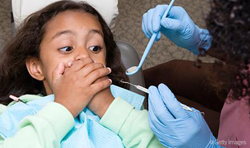Two-phase orthodontics: There are two sides to every story
Several orthodontists examine the benefits and risks of two-phase treatment.

Parents are often surprised to learn the American Association of Orthodontists (AAO) suggests that children have a checkup with an orthodontist by the age of seven. Many consider braces to be a teenage rite of passage.
However, assessment at a young age can indicate whether a child has the potential for a complicated case or, more importantly, has an orthodontic condition that would benefit from an early correction in the mixed dentition.
Or does it? Some orthodontists argue that treating patients at such a young age takes longer, costs more and leads to more patient burn out. They argue that in most cases, clinicians can achieve the same results in traditional, one-phase treatment options that occur between the ages of nine and 14, or later.
So who is right? Can parents get help too early or, worse, too late? We spoke to some experts in the field to determine what considerations should be in play when deciding when to start orthodontic treatment for children.
Different Phases, Different Goals
In the two-phase treatment plan, each phase focuses on distinct goals. Phase 1 treatment corrects existing or developing skeletal or muscular orofacial environments before the arrival of all the patient’s permanent teeth. It aims to amend the jaw position to accommodate the existing teeth as well as those that will come in later. Phase 2 treatment, on the other hand, concentrates on final alignment. The time between the two phases can range from months to years.
However, few orthodontists believe two phases are necessary for all patients. Dr. Randy Lang, DDS, D. Ortho, is in private practice in Mississauga, Ontario, and also teaches orthodontics at the University of Toronto. He thinks only a few specific cases require two phases, and that for the remainder, two-phase orthodontics treatment plans usually take longer and cost more. Furthermore, no scientific literature proves that the treatment result is better than one-phase treatment. He feels that parents should be informed of these facts and given a choice of when to proceed as a matter of informed consent.
Like Dr. Lang, Aaron Goodall, Director of Business Intelligence at Ormco and formerly the Director of Clinical Affairs, agrees that choosing two-phases versus one-phase treatments depends on the particular case you are treating.
“I believe a clinician can make the case for either treatment philosophy," says Goodall. "Clinical judgment (diagnosis) dictates the treatment plan, which may end up being two-phase or one.”
Goodall explains that a typical Phase 1 objective goal is to intercede early in order to allow for more efficient Phase 2 treatment. For example, broadening a constricted maxilla may allow room for teeth to drop.

Furthermore, there can be psychosocial rationale for Phase 1 treatment. “If a patient is bi-max and lip incompetent, early treatment may not only minimize the chance of being teased," says Goodall, "but also render benefits for highly active kids. Retroclining anteriors may reduce the risk of injury from meeting a Rawlings in the face.”
Dr. Jeff Summers, an orthodontist practicing since 2003 with a private practice in Greenville, South Carolina, said parents ask him all the time why there are two phases of treatment now, as compared to the one they remember when they were kids. He explains that there were always stages of treatment, but that now orthodontists have better defined goals for the phases.
Related article: 10 ways to handle parents of your pediatric patients
“You’ve heard those stories of people being in braces for five to six years,” Dr. Summers says. “What happened is the orthodontists started treatment early to accomplish some of the same goals that we would have in Phase 1 and then that treatment just carried through to the comprehensive. It just ended up in one long phase of braces. Now, we have established some finite goals for Phase 1. Once those goals are met, we give the kids in braces, and their parents, a break. And then re-initiate treatment.”
Scientific literature supports our experts’ opinions. In a study published in the Journal of International Oral Health, researchers also conclude that certain cases might benefit from treatment planning in the mixed dentition stage. However, they said that there is more danger in “too much too soon, rather than in too little too late.”3
Up next: Who needs Phase 1 Treatment?
Who Needs Phase 1 Treatment?
Dr. Summers said he only recommends the two-phase treatment plan for around 10 percent of his patients. These patients tend to fall in one of four categories:
- Patients with a cross bite: Correcting a cross bite early can be easier and can prevent a lower jaw problem from worsening and becoming harder to fix later.
- Extreme crowding: Creating room for blocked-out teeth can either avoid or reduce the need for extraction in the future.
- Protrusive front teeth: Front teeth that stick out are at higher risk for trauma, bringing them back reduces that risk.
- Psychosocial protection: Putting braces on some kids can make a significant impact on their emotional well-being.
“Those are times where the kids don’t ‘need’ braces, but they need braces,” Dr. Summers says of the psychosocial group. “From a parental perspective, we look at our kids, and we want to do whatever we can to help them go through these tough stages where children are not so kind. And sometimes braces can help boost self-esteem and are an important part even if there’s not a direct need for them medically, orthodontically speaking.”
Related article: How Opalescence Go can restore confidence in pediatric patients
All the experts consulted agreed that two-phase treatment isn’t for everyone, however. In most cases of Class I malocclusion, which is mostly crowded teeth that protrude, early treatment won’t prevent future treatment. In these cases, save for the psychosocial exceptions, patients might have started too early.
Does that mean patients can start too late? According to Dr. Summers, it could, depending on your goals for treatment.
“If your goals are to broaden up her arch and prevent the lower jaw from continuing to grow asymmetrically, then sometimes it’s too late," says Dr. Summers. "So she’s already developed a lower jaw problem. That can be difficult. Those are the patients you look at and say ‘Gosh, I wish I would have seen you two years ago.’”
Up next: The verdict on the AAO recommendation
Other examples of starting too late could be if the front teeth have already suffered trauma, or if the cross bite has chipped or caused periodontal problems. For these reasons, Dr. Summers supports the AAO recommendation of having the first orthodontic evaluation at age seven. He sees it as maintaining a high standard of patient care, rather than a chance to “sell” orthodontic services. He doesn’t charge for this appointment in his practice, which includes photographs, cone beam evaluation and a thorough clinical examination.
“It gives us an opportunity to educate the parents and sometimes we can be more proactive in helping to guide the eruption of teeth and eliminate a Phase 1 treatment, " explains Dr. Summers. "Often, that comes with no charge for the patient. It’s just an opportunity for us to monitor and help guide and inform them, which is a tremendous service to the patient.”
Dr. Lang wrote over ten years ago that there is nothing wrong with multi-phase treatment approach to Class II malocclusions, particularly cases where maxillary incisors are extremely protruded. However, two-phase treatment plans should not be the routine for all Class II cases.
“My feelings are still the same,” he says when asked whether his opinion has changed over the past 15 years.
Goodall agrees that individual cases need early intervention, but that others might benefit from waiting to see what happens without help.
“In some cases, the malocclusion works itself out without intervention. There are times when malposed teeth at age eight are better positioned at age 12,” Goodall explains. “Sometimes just waiting and seeing what God gave you can work out for the best.”
1. “Your Child’s First Orthodontic Check-Up, No Later Than Age 7.” Res.cloudinary.com. Web. 24 October 2016. < http://res.cloudinary.com/dorhu9mrb/image/upload/v1453397442/Your_Childs_First_Checkup-15-cons-hl.pdf
2. “One Phase vs. Two Phase Orthodontic Treatment-Which is Best?” www.oralhealthgroup.com. 1 September 2001. Web. 24 October 2016. http://www.oralhealthgroup.com/features/one-phase-vs-two-phase-orthodontic-treatment-which-is-best/.
3. Suresh, M et al. “One Phase versus Two Phase Treatment in Mixed Dentition: A Critical Review.” Journal of International Oral Health: JIOH 7.8 (2015): 144–147. Print.
Product Bites – November 3, 2023
November 3rd 2023The weekly new products podcast from Dental Products Report is back. With a quick look at all of the newest dental product launches, Product Bites makes sure you don't miss the next innovation for your practice. This week's Product Bites podcast features new launches from Premier Dental, Denti.AI, and Clear Correct. [3 Minutes]
Oral Health Pavilion at HLTH 2024 Highlighted Links Between Dental and General Health
November 4th 2024At HLTH 2024, CareQuest, Colgate-Palmolive, Henry Schein, and PDS Health launched an Oral Health Pavilion to showcase how integrating oral and general health can improve patient outcomes and reduce costs.